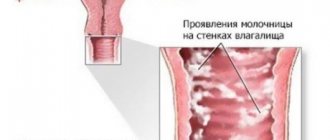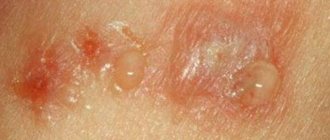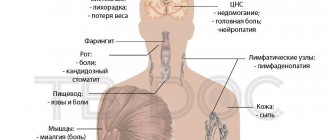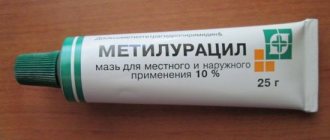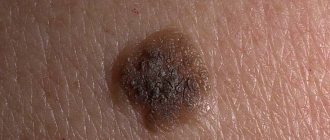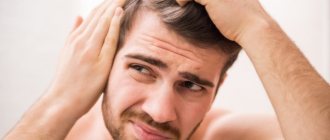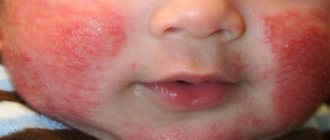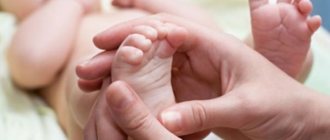Description of the disease
Microsporia is recognized as the most common fungal disease among children.
The peak incidence occurs in late summer and early autumn. Sources of infection are sick people and animals (usually cats). There are 2 types of microsporia pathogens - anthroponotic and zooanthroponotic strains. The former are dangerous only for humans, the latter infect humans and animals. Children have a natural tendency to microsporia. This is due to the fact that in childhood the composition of the secretions of the sweat and sebaceous glands differs. In adults, the secretion contains many fatty acids, which are harmful to the fungus. In children, the protective function of the skin is weak, so they are more susceptible to dermatophytosis.
The microsporum fungus can infect smooth skin, hair, and very rarely grows into nails. Its waste products have toxic properties, therefore they provoke inflammation of the skin, peeling, and itching. When the hairy parts of the body are affected, the fungus invades the hair follicles, then affects the entire length of the hair, causing brittleness and hair loss.
Prevention of the disease is carried out at the state level. The sick person must be isolated from healthy people for 35 days. The fungus spreads along with scales that peel off from the skin. The risk of developing microsporia is higher for children in the following categories:
- weak immunity;
- abrasions, scratches, wounds on the skin;
- avitaminosis;
- pathologies of the endocrine system;
- dysfunctional family environment.
Microsporia
Signs
The incubation period of the disease is 5-7 days.
With microsporia of smooth skin, a swollen red spot with clear edges appears at the site of the fungus penetration. The spot grows, and a ridge of small nodules, bubbles and crusts forms along its edge. After some time, the inflammation in the center of the spot goes away, the skin there becomes pale pink, and peeling appears on the surface. Often this process is accompanied by moderate itching. Usually 1-3 spots with a diameter of 0.5 to 3 cm appear on the body. They are mainly located in the face, neck, and arms.
Very rarely the nails are affected. In this case, a dull spot first appears on the nail plate, which later turns white. In the area of this spot, the nail becomes more fragile and can easily break.
With microsporia of the scalp, a rounded lesion with clear edges first forms at the site of infection and peeling begins. A white ring-shaped scale forms around the affected hair. The skin in the affected area is red, swollen, covered with blisters filled with liquid, in place of which, after some time, crusts form. The affected hair becomes brittle and breaks off at a distance of 4-6 mm above the skin level, forming stumps. The stumps are dull and covered with a grayish-white coating - fungal spores. Another sign of the disease is that if you stroke the stumps, they deviate to the side and do not return to their original position.
There is also a suppurative form, in which soft bluish-red nodes covered with ulcers form at the site of the lesion. When pressed, pus flows out of them. This form develops with inadequate treatment of the disease.
In animals, microsporia is manifested by baldness of the skin on the face, ears, front or hind legs.
Description
The reason for microscopy is fungi of the genus Microsporum. These can be anthropophilic, that is, affecting only humans (Microsporum audoinii, Microsporum ferrugineum), zoophilic, that is, parasitic on animals (Microsporum canis, Microsporum distortium, Microsporum equinum) and geophilic, that is, living in the ground (Microsporum gypseum) fungi . Two species are common in Russia - Microsporum canis and Microsporum ferrugineum.
Microsporia is widespread and is one of the most common fungal infections. Residents of Western Europe, Southeast and Central Asia, Transcaucasia, Japan and the USA are more likely to get sick. Mostly children suffer from microsporia. This is due to the fact that as we grow older, the composition of the secretions of the sweat and sebaceous glands changes. It contains more fatty acids, which are harmful to the fungus. Among adults, young women are affected, but this is rare.
The source of the disease are people and animals (cats, dogs, guinea pigs, hamsters, rats) suffering from microsporia. The infection can be transmitted through personal contact, as well as through shared household items, clothing, toys, stationery and bedding.
Children are most often infected:
- with a weakened immune system;
- those suffering from endocrine diseases (diabetes mellitus, hypothyroidism);
- suffering from hypo- and avitaminosis;
- having abrasions, scratches, cracks in the skin;
- from disadvantaged families.
The peak incidence occurs in late summer and autumn. This is associated with the breeding of offspring in wild animals.
Once on the skin, the fungus penetrates it and begins to multiply. If there is a hair near the injection site, the fungus grows into its bulb, spreads along its entire length, and its spores accumulate between the hair scales. The mushroom completely surrounds the hair, as if forming a cover on it.
Diagnostics
The diagnosis of microsporia is made by a dermatologist based on an examination of the patient and laboratory test data. To confirm the fungal nature of the disease, it is necessary to do a microscopic examination of scrapings from the affected skin. If the scalp is involved in the pathological process, hair from the affected area is also examined.
A culture test is also carried out to determine the type of fungus. To do this, the material under study (skin flakes and hair) is sown on a nutrient medium.
If microsporia is suspected, a fluorescent study is performed with a Wood's lamp - in the light of this lamp, the affected areas glow green.
The patient also undergoes general and biochemical blood tests, and a general urine test.
Treatment
To treat smooth skin microscopy, antifungal drugs are used externally. In addition, it is recommended to lubricate the lesions with a 5% alcohol solution of iodine in the morning.
In cases of severe inflammation, combined ointments containing an antifungal drug and glucocorticoid hormones are prescribed to relieve inflammation.
If vellus and long hair are affected, antifungal drugs are prescribed orally (by mouth).
When treating microsporia of the scalp, the hair is shaved once a week. You need to wash your hair twice a week. Antifungal drugs are also used internally in the form of tablets and externally in the form of ointments.
Lifestyle
Those suffering from microsporia should not go to kindergarten or school, to sports clubs, or to the swimming pool.
Children who have recovered from the disease are monitored by a doctor for a year. They should undergo timely testing for fungal infection to prevent relapse of the disease.
The things of a person suffering from microsporia must be disinfected.
Prevention
Prevention of microsporia involves maintaining personal hygiene. It is imperative to wash your hands after contact with any animals, since animals that do not show signs of illness can be carriers of the fungus.
If you suspect microsporia in a pet, you should contact your veterinarian as soon as possible.
It is very important to promptly identify patients with microsporia and isolate them from other children.
© Dr. Peter
Symptoms of microsporia
The main symptom of microsporia is characteristic skin rashes. In the zone of penetration of the fungus into the skin, a red spot with raised edges appears. As the pathogen multiplies, it expands and looks like a ring. Inside the rash, the skin is of a normal or pale pink color, covered with a powdery coating or peels off with peeling crusts. There may be reddish bubbles or nodules along the perimeter of the spot. Moderate itching of the skin in the area of the rash is possible. With massive seeding, several spots appear at once, which merge with each other over time. Most often, rashes appear on the arms, forearms, shoulders, neck, and legs. When infected from animals, the hairy areas of the skin on the head are affected. The affected hair breaks off at a distance of 3-5 mm from the surface of the skin, leaving behind “stumps”. As the fungus spreads, rounded areas of baldness form on the child's head. The area affected by the fungus may itch. Local immunity is impaired here, so secondary infection of the foci with the development of inflammation is possible, incl. purulent. Children often scratch the affected areas, causing the skin to become wet.
Symptoms
The main symptom of ringworm is a pinkish-red patchiness of the skin. But since bright spots are also signs of other diseases, it is important to know the clinical features of microsporia and be able to differentiate the pathology from other ailments.
What are the symptoms of microsporia of smooth skin based on the nature of the rash:
- Clarity of lesions and presence of boundaries.
- The shape of the spots is oval or circle.
- Size variability - the diameter of each lesion is 0.5 - 3 cm.
- Weak pityriasis-like peeling in the core of the spot, the presence of small nodules and blistering.
- Swelling of the affected area. The lesion thickens and rises above normal skin.
- The spots tend to merge.
- The centers of the spots lighten and acquire new foci.
- A slight itching appears, the body temperature rises, and the lymph nodes swell. Those lymph nodes located behind the ears are especially enlarged.
Without timely medical care, microsporia progresses, causing the spots to grow around the periphery. In the lesions, the central part becomes noticeably lighter, and the spots then take on ring-shaped shapes.
Ringworm is localized on almost the entire body - neck, shoulders, forearms, face, upper and lower extremities. Spots rarely form on the palms, nails and soles of the feet.
Causes of microsporia
A child can encounter a pathogen anywhere. Infection with zooanthroponotic strains occurs through contact with stray animals. Cats suffer from microsporia more often than dogs. Rashes appear in the area of direct contact with a sick animal (where the cat rubbed itself). Anthroponotic strains are transmitted by humans. It is enough for infected scales to get on the skin of a healthy baby. You can become infected in kindergarten or public transport. The fungus is transmitted through household items. Most often, children become infected from adults when sharing a towel.
Classification and signs of microsporia
Ringworm (microsporia) is diagnosed 4 times more often in children than in adults. Boys are more susceptible to the disease. Depending on the location of the foci, 3 types of microsporia are distinguished:
- nail plates (onychomycosis);
- smooth skin;
- scalp.
Of particular importance is the classification of the disease according to the depth of the lesion and the severity of symptoms. Depending on the nature of the changes, the following forms of ringworm are distinguished:
- superficial - only the horny (uppermost) layer of the epidermis is affected, so light pink circles appear in places where the fungus is localized;
- exudative – the pathogen penetrates deep into the skin, causing weeping;
- infiltrative-suppurative - a bacterial infection enters the damaged areas, resulting in the formation of ulcers;
- chronic – a variant of the sluggish course of the superficial form of mycosis.
In 75% of cases, microsporia of smooth skin is diagnosed.
Without treatment, the harmful fungus spreads to the head and nail plates. Primary lesions form mainly on the arms, neck and other exposed parts of the body. A swollen pink spot appears at the site of the lesion, which gradually increases. Small bubbles appear on the periphery, and areas of peeling appear in the center. Therefore, large spots with concentric rings inside form on the body. The number of inflammatory foci ranges from 3-5 pieces. The person complains of moderate itching, and in the suppurative form, of pain.
Microsporia of the scalp is detected in children 5-12 years old. Characteristic spots appear on:
- crown;
- back of the head;
- crown;
- temples.
Typical symptoms of microsporia on the head:
- 1-2 spots up to 5 cm in size;
- peeling of the skin at the edge of inflammatory foci;
- hair breakage;
- grayish coating on hair stumps.
During puberty, hair follicles secrete acid, which destroys the fungus. Therefore, self-healing often occurs in children aged 11-13 years.
Nail microsporia occurs in 1% of cases. People with chronic diseases and immunodeficiency conditions are susceptible to it. Onychomycosis is indicated by:
- yellowing of the nail plates;
- dull spots in the growth zone;
- thinning and brittleness of nails.
In people with atopic dermatitis, microsporia often resembles dermatosis. Therefore, treatment with corticosteroids only aggravates the symptoms and provokes the spread of infection.
Diagnosis of microsporia
Dermatologists at SM-Doctor have extensive experience in diagnosing and treating microsporia in children. Specialists pay a lot of attention to the general health of the little patient in order to identify factors predisposing to the disease. With an integrated approach, microsporia can be quickly eliminated. The diagnosis is made by a dermatologist based on the clinical picture. As a rule, there is a history of being in the village or contact with a stray animal on the street. The diagnosis can be confirmed by examination with a Wood's lamp (the lesions glow green). To assess the general condition of the body, general and biochemical blood tests are prescribed. To clarify the type of fungus, scrapings and inoculation on a nutrient medium are examined.
Diagnostics
After external signs appear, the disease is diagnosed using two methods: by examining it with a special lamp or by taking a skin scraper from the affected area. At the first appointment with a doctor, a fluorescent lamp is brought to the hearth in a dark room, which will show a green glow in case of infection with a fungus. In the first two days after the appearance of the red spot, there may be no glow, so at an early stage this method may be useless, but during treatment this procedure will quickly show whether the prescribed treatment is effective. The examination is recommended every 3 days.
Laboratory tests can provide a more accurate picture. When taking skin samples, the affected area will be treated with alcohol, and then a few dry scales will be carefully scraped off and sent for analysis under a microscope. An observer, if the patient truly has microsporia, will easily detect a large accumulation of spores.
Top
Treatment of microsporia
Microsporia in one child can lead to a real outbreak of the disease within a family or children's group, since the pathology is very contagious.
Treatment should be started immediately. It is important that it be selected by a doctor, since therapy differs from case to case. SM-Doctor doctors select treatment on an individual basis, taking into account the general condition of the little patient and his existing concomitant diseases. Treatment of smooth skin microsporia involves the external use of antifungal agents. In case of severe inflammation, ointments and creams with a combined composition (antifungal + anti-inflammatory component) are prescribed. Treatment with external antimycotics is alternated with lubrication with iodine solution.
If vellus or long hair is affected, external remedies alone cannot be used. Systemic antifungal drugs are prescribed (in the form of tablets or capsules). Treatment is supplemented with ointments. Shaving of hair and washing hair with antifungal shampoos is recommended. Treatment lasts from 2 to 6 weeks.
During treatment, the child must be isolated. All personal and household items must be disinfected. After recovery, the patient should undergo clinical observation, since microsporia can recur.
Treatment
The combination of drugs prescribed to the patient depends on the severity of damage to the skin, nail plates and hair follicles. Antifungal therapy may be local or general. In the first case, a child or adult needs to use creams and ointments that suppress the activity of the microsporia pathogen. Drugs in this group are not recommended for use by girls during pregnancy and lactation. Topical sprays are effective in treating large areas of ringworm. Modern formulations do not leave stains on the skin and are not absorbed into the fabric of clothing.
A severe inflammatory reaction is treated with a combination of antifungal and hormonal drugs. Patients will have to apply ointment applications to the affected areas. After this, the skin is treated with iodine solutions. The oral tablet intake schedule is formed by a dermatologist based on the clinical picture of the pathology.
The addition of a secondary infection to microsporia involves the use of drugs based on betamethasone, gentamicin or clotrimazole.
Prevention of microsporia
To prevent microsporia in children, it is necessary from early childhood to teach them to wash their hands upon arrival home, after using the toilet, after visiting public places, before eating, after contact with animals. It is necessary to limit the baby’s contact with homeless animals. If you have cats and dogs at home, you should consult a veterinarian regularly. If a patient with microsporia appears at home, you need to carry out disinfection daily (wash clothes, towels, bedspreads, wipe surfaces with a solution of laundry soap and soda). SM-Doctor doctors specialize in the treatment of childhood pathologies. A caring attitude, an integrated approach and professional monitoring of all stages of treatment will allow your baby to recover in the shortest possible time!
What is the characteristic of microsporia in humans?
Microsporia is a common infectious disease caused by a fungus belonging to the Microsporum genus. Many diseases are explained by the fact that this pathogen is well preserved in the environment and on objects on which it can live for up to several years. It is observed in significant quantities in animals, on vegetation and in soil.
Microsporia affects both the smooth epidermis and can spread to the scalp.
This disease is observed in children and is caused by several fundamental factors.
Because the child’s immune system is much less developed than that of an adult, and the body is easily susceptible to any infection.
Children love to play with outdoor cats or dogs, whose fur may contain this fungus.
Microsporia has a distinct seasonal character, and its greatest prevalence is observed in the summer, when animals have offspring to whom they can transmit the pathogen. And children often lack clear rules of personal hygiene.
Microsporia exists in 2 varieties. In the first case, microsporia is a superficial lesion of the epidermis, which manifests itself in the form of reddish or pinkish plaques with flaky outlines.
The disease is caused by a pathogen that is transmitted from person to person and causes damage to people. The second is a severe form of microsporia, which is caused by pathogens observed in animals.
Cats and dogs serve as reservoirs of infection. With this disease, the deeper layers of the skin are involved in the process of damage, this is the beginning of the inflammatory process and leads to the formation of purulent infiltrates.
Frequent symptoms will be: fever, general weakness and malaise, nausea. The first and second types of microsporia are characterized by the appearance of itching, which can sometimes manifest itself to a small extent, and sometimes can be of pronounced intensity.
What does home medicine recommend?
Treatment of ringworm with folk remedies at home involves treatment with self-prepared ointments.
Let's look at some of the most popular ointment recipes:
- It is necessary to grind (preferably in a blender) the May leaves of the plantain. Then pass through a sieve, you should get one glass of juice. Then add one tablespoon of birch bark ash and one teaspoon of medical alcohol to it. Mix everything thoroughly and let it brew for several hours. Apply the prepared ointment to the affected areas of the body in the morning and in the evening before bed. If you approach this process responsibly and lubricate it every day, the result will be noticeable within a week.
- Beetroot ointment helps to easily get rid of itching and at the same time restore the skin and hair growth. To do this, you need to take one medium beet and boil it thoroughly until it becomes soft. Then you need to peel and grate on a fine grater. As much beets as you get, add the same amount of honey. The resulting mixture must be mixed and placed in the refrigerator for 24 hours. Lubricate the lesions three times a day, preferably after bathing.
- For women with long hair, regular antifungal therapy is necessary.
Classic treatment for ringworm
In medicine, there is a certain method of treating this disease, which has been developed over the years. For this purpose, specialists:
- First, remove hair from all areas affected by the fungus;
- then treat the affected area with an alcohol tincture of iodine. This procedure is performed every day in the morning;
- in the evening, lubricate with antifungal ointment.
If you notice the first symptoms of ringworm in a child, treatment should be started immediately. Under no circumstances should you treat the disease yourself with folk remedies. Only after the doctor makes a final diagnosis will he give you recommendations for treatment at home.
It is not possible to quickly get rid of microsporia in a child; this may take at least 3 weeks.
For treatment to be effective, keep the apartment clean and give your child antifungal medications. Doctors recommend regularly quartzing a child’s personal clothing with an ultraviolet lamp.
Microsporia smooth skin treatment
The causative agents of this disease are highly resistant to antibiotics, so large doses of drugs are required for use.
The most common medications for the treatment of microsporia are griseofulvin (an antifungal antibiotic with a fungistatic effect) and lamisil.
Griseofulvin is taken orally with the addition of vegetable oil. The oil helps increase the secretion of bile and dissolve the antibiotic faster. It is recommended to drink it with apple or lemon juice so that griseofulvin is easily absorbed. This antibiotic has a rather negative effect on liver function. For this, experts recommend taking Karsil together with it. The disease should be treated with this antibiotic for 2 months, the daily dose of the drug is 1 g. Lamisil is also an effective drug in the treatment of microsporia. This drug is easily absorbed into the digestive tract and acts specifically on fungal cells. Even in severe and advanced forms, the drug easily copes with the disease.
In addition to antifungal drugs, doctors use external agents. Every seven days, the hairy area of infection is removed with a razor or epilation.
Every day in the morning the affected area is treated with iodine. Before going to bed, apply antifungal or sulfuric ointment, which contains salicylic acid and tar.
In advanced forms, compresses with a solution of ichthyol, licorice root and mumiyo will help get rid of bloody crust or pus. They also make cotton pads with antiseptic preparations. If a child is infected, then 1% Travogen and Mycospor cream will help.
Symptoms
For all types of fungal infections, there are common symptoms:
- Reddish spots appear on the skin. They can be of different sizes, but mostly they are all round in shape;
- the skin begins to peel off and diaper rash appears;
- the area of interdigital folds changes;
- the affected area is itchy.
The specific course of the disease depends on which part of the skin is infected. During microsporia, the hair begins to break off 2-3 ml above the skin.
Ringworm can also affect the skin of the face, including the neck, chin and lower lip. It also causes ringworm, which damages beard hair follicles. It is accompanied by swelling of the affected areas, and bloody crusts are observed at the site of infection.
If microsporia affects the skin of the hands, then peeling and cracks in the interdigital folds are observed.
Very often you can notice a fungus on the skin of the feet; it affects the sole and interdigital folds. The skin of the feet turns red, cracks and blisters appear between the toes, usually between the little and ring fingers. The stratum corneum on the feet thickens and cracks appear. Blisters begin to form on the side of the foot, which later merge into one large bubble. If you open them yourself, you will be left with a lesion in the form of a hole with uneven outlines.
Microsporia on the body appears as rounded red spots with clear boundaries and have a slightly convex appearance. Localized in the shoulders, back, forearm, chest and neck. The skin becomes very red and begins to peel.
Infection of the groin area is caused by fungi of the genus Candida, an aqueous suspension of the bacterium trichophyte, as well as ringworm fungi - epidermophytes. It affects the inner thigh, perineum, groin, and sometimes affects the genitals. It is also called “jockey itch” and can affect both men and women. It is transmitted mainly through intimate intimacy. Adult men are more often affected. It is characterized by peeling, dark red rashes with a brown tint, and has clearly defined boundaries. Cracks and blisters containing liquid appear on the affected area.
The skin around the affected areas also turns red and peels.
Prevention
To prevent dermatomycosis and the spread of infections in the human body, specialists take strict preventive measures. There is a certain database of patients with a confirmed diagnosis.
Doctors conduct an examination of the patient’s entire family, people with whom the patient has come into contact, to identify possible microsporia infection.
The pet is also examined to refute or confirm the infection of the pet. If foci of microsporia are not visually visible on the animal, then it is sent to a veterinary clinic and examined under a special lamp, a wool culture is done, if the disease is detected, then treatment is prescribed at a veterinary clinic .
Treatment with folk remedies
Trichophytosis will go away quickly and without consequences if you prepare and regularly rub in herbal infusions. The most popular folk remedies:
- One tablespoon of pharmaceutical chamomile is poured with boiling water (250 ml). Leave for several hours. Then rub it into the affected areas every day. This procedure must be carried out at least three times. The result can be seen within a week. After rubbing this solution into the hair, the hair is effectively restored.
- The most common and powerful infusion in the fight against microsporia is considered to be an infusion of chamomile, acacia flowers and lilac. Preparation recipe: you need to take two tablespoons of each plant and pour a glass of medical alcohol, place everything in a jar and add 10 ml of apple cider vinegar. This infusion is infused for six days. then filter through a fine sieve or cheesecloth. The affected areas are wiped twice a day. The course of treatment is five days.
- Propolis tincture is popular among people. You can buy it or prepare it at home. To do this, you need a natural bee product (50 g). Propolis is filled with 200 ml of alcohol. The container in which the propolis will be infused should not allow air to pass through, i.e. close tightly. Infuse in a dark place for one month. Shake occasionally, but do not open the lid. The lesions are treated with infusion four times a day. The course of treatment is a week.
- A simple and effective product in the fight against lichen is an egg. To do this, you need to remove the yolk and white from one raw egg (preferably homemade and fresh), so that only one shell remains. Clean the shell from the film and excess liquid under it, and lubricate the affected areas with it. This procedure is carried out three times a day and the result can be seen after a week.
- One of the ancient remedies - raisins - will help get rid of lichen. To treat microsporia you need black raisins. The active substances contained in it will help you quickly deal with parasitic fungus. This recipe came to us from Ancient Persia. One teaspoon of black raisins is poured with a large amount of boiling water. After the raisins swell, grind them well. The resulting ointment is used to lubricate the lesions several times a day, more if possible. For better results, doctors also recommend drinking raisin decoction.
- Apple cider vinegar lotions help. To do this, soak a cotton swab in undiluted apple cider vinegar and apply it to the affected area for 1-2 minutes. Apply lotions at least five times a day.
- Chamomile infusion will help get rid of ringworm on the head. Pour ten grams of chamomile into one glass of boiling water and let it brew for half an hour. Before washing your hair, you need to rub in the infusion and walk for about 40 minutes.
- Lubricating the lesions with plantain, namely its juice or mucus, will help rid the child of microsporia.
- Celandine will help get rid of lichen. It is used while taking a bath.
There are many traditional methods for treating ringworm; we have selected popular ones that have been proven by experts. These recipes will help you quickly cope with even severe illness. The main thing is to follow the rules and not skip procedures. It is better to choose one method and complete the full course than several at once.
You also need to remember that the main reason for the appearance of microsporia is considered to be weak immunity, so try to strengthen it. This can be done with proper nutrition and a healthy lifestyle. Eliminate foods that cause allergic reactions from your diet, and do not overeat.
Follow the correct daily routine: it is advisable to sleep at least eight hours a day. It is recommended to play sports and spend more time in the fresh air.


